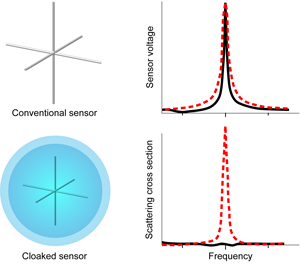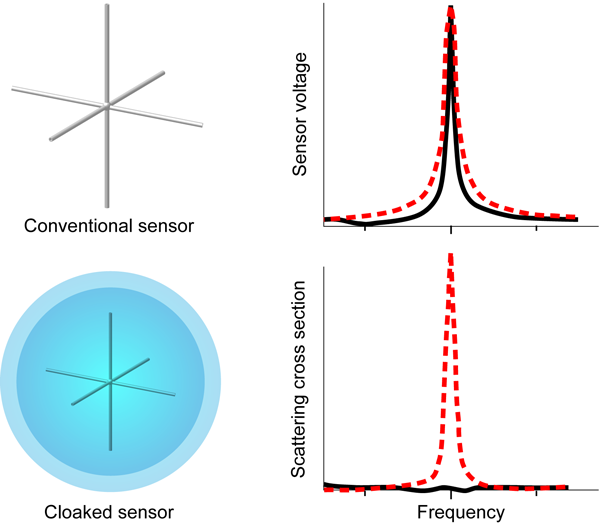Seeing without being seen
Over the past decade, researchers have reported several impressive discoveries aimed at controlling the flow of light in ways that defy common intuition. Andrea Alù and Nader Engheta, at the University of Texas at Austin and the University of Pennsylvania, in a paper in Physical Review Letters now propose a way of sensing with light through a nearly invisible detector [1]. This follows previous related findings, such as experimental demonstrations of resonant magnetic response at optical frequencies [2], optical cloaking [3], negative light refraction [4,5], and super-resolution imaging [6,7]. On the theoretical side, recent designs are reaching the limits of our imagination with works on invisible materials [8,9], multifrequency optical cloaking [10], and nanoscale optical circuits [11] using so-called nearly-zero-epsilon media (where is the permittivity or electrical “polarizability” of the material) [12], while the field of transformation optics (that is, the search for complex electromagnetic solutions through coordinate transformations starting from free space propagation) [13] is emerging as a powerful analytical tool.
The secret of these findings lies in the manipulation of electromagnetic fields over distances that are small compared to the light wavelength. For example, so-called metamaterials that are tailored on such length scales to exhibit artificial optical properties that are not encountered in nature [4] provide the necessary fabric to implement the ideas noted above. Innovative solutions of Maxwell’s equations are at the heart of these discoveries, and these solutions have been formulated for more or less complicated structures, with the use of substances that are described through their frequency-dependent permittivities . With notable exceptions, such as the recent demonstration of an all-dielectric cloak [14], the new advances rely on subwavelength resonances that can be best produced using metals (for example, through collective conduction-electron motion, also known as plasmons).
The idea of Alù and Engheta is neat and simple, and has extremely powerful consequences (Fig. 1): A conventional sensor, which they describe through an isotropic dipole element, derives its power to sense from its ability to strongly interact with an external electromagnetic field (the signal to be sensed), and therefore it imprints a significant disturbance on the sampled field, thus making its presence conspicuous. This disturbance can be reduced to a minimum by surrounding the sensor with a cloaking shell of conveniently chosen materials, leaving the sensing capacity intact, but rendering the sensor invisible in practice.
Alù and Engheta elaborate their concept of an invisible sensor starting from their earlier work on optical transparency [8]. They showed that the scattering cross section of an isotropic object (the dipole element in their most recent work) can be drastically reduced by surrounding it with a spherical shell made of a negative-permittivity material. The effect here is not that the fields are blocked because is negative. Although that is true for large structures, in this case the shell is relatively thin and the negative permittivity is needed to produce electromagnetic resonances (see below). Metals exhibit the required behavior, leading to the existence of localized plasmon excitations at visible and near-infrared frequencies. However, it is possible to achieve at lower frequencies using metamaterials [4], and this allows the extension of these concepts to a wide spectral domain, ranging from the visible to the microwaves.
Surprisingly, the scattering cross section decreases by adding a suitably tuned shell, and, consequently, by making the sensor structure larger. By conveniently choosing the shell thickness and its dielectric properties, Alù and Engheta find that the object becomes practically undetectable. But in contrast to other types of optical cloaking [3], the electric field intensity is nonzero inside the plasmonic shell, and this allows a resonant sensor to deliver a substantial signal while reducing the overall scattering to a minimum, which would not be possible in other cloaking schemes aimed at completely excluding any electromagnetic interaction between the cloaked region and the region outside the cloak. In the new, cloaked sensor, the shell is designed to nearly suppress the scattering cross section of the combined system formed by the dipole element and the cover shell. The resulting device exhibits a relatively undiminished output signal at the peak of the sensor response, but the scattering cross section is dramatically reduced to negligible levels over a wide spectral range [1]. Of course, both the scattering and the sensing operate at the same frequency as the original uncloaked conventional sensor (Fig. 1).
The proposed device benefits from the properties of evanescent fields that can be present in metamaterials. At very short distances compared to the wavelength (the near field regime), the electric field can undergo tremendous amplification with respect to the incident signal. And because evanescent waves do not transport electromagnetic energy, this can occur without ultimately disturbing the incident signal in the far field. Such amplification is typically mediated by localized resonances, whereby light is trapped in deep subwavelength regions. In a simplified picture of these resonances, their electric field can be reasonably well described through Poisson’s equation (the long wavelength limit of the electric part of Maxwell’s equations).
Interestingly, this equation also rules the transport of heat under stationary conditions, with the permittivity and the electric potential playing the role of heat conductivity and temperature, respectively. Combining the second law of thermodynamics (which implies that the conductivity is positive) and common intuition (heat cannot be trapped indefinitely in passive media), it is apparent that materials cannot trap electromagnetic energy in the long-wavelength limit. Fortunately, media exist (metals at high frequencies, polaritonic materials in the infrared, and purposely designed metamaterials over a wide spectral range), which can trap electric fields (plasmons, optical phonons, etc.) involving evanescent fields. These fields are the mechanism used in the proposed cloaked sensor, which has been designed such that the shell plasmon exactly cancels the scattering of the sensor resonance, without affecting its capacity to sense [1].
As can happen in a new field, the work of Alù and Engheta implicitly poses questions about the limits of invisibility for a sensor. For example, from a classical point of view, the enhanced electric field at the sensor could be used to control a current without having to extract energy from the external field for actually detecting the current. From a quantum perspective, sensing involves erasing a quantum state [15], and this might impose a lower limit to the degree of invisibility that can be achieved while sensing, perhaps at the single-photon level (for example, by nondestructively detecting one photon from the incident field, although this requires a change in the overall quantum state of the detector, thus producing decoherence in the detected photon and therefore reducing the invisibility).
Several applications suggest themselves, because the concept of cloaking a sensor is general; the challenge will be finding the right designs to apply this idea to situations other than a point dipole. Extracting a signal out of the cloaked sensor could be achieved by re-emitting at a different frequency outside the cloaked window (for example, through fluorescence after excitation by the sensed field). This could provide a route towards noninvasive diagnosis in medicine, in which nanoshells [16] consisting of a fluorescent core and a plasmonic shell appear as natural candidates for nanoscale implementations of cloaked sensors. The possibility of seeing without being seen immediately suggests applications to security combined with radar technology, which will require the use and further development of plasmonic metamaterials at low frequencies, including active structures capable of compensating undesired losses. Such developments will help to further consolidate plasmons as the natural tool to process light at subwavelength scales.
References
- A. Alù and N. Engheta, Phys. Rev. Lett. 102, 233901 (2009)
- T. J. Yen, W. J. Padilla, N. Fang, D. C. Vier, D. R. Smith, J. B. Pendry, D. N. Basov, and X. Zhang, Science 303, 1494 (2004)
- D. Schurig, J. J. Mock, B. J. Justice, S. A. Cummer, J. B. Pendry, A. F. Starr, and D. R. Smith, Science 314, 977 (2006)
- D. R. Smith, J. B. Pendry, and M. C. K. Wiltshire, Science 305, 788 (2004)
- A. Boltasseva and V. M. Shalaev, Metamaterials 2, 1 (2008)
- J. B. Pendry, Phys. Rev. Lett. 85, 3966 (2000)
- J. Zhu and G. V. Eleftheriades, Phys. Rev. Lett. 101, 013902 (2008)
- A. Alù and N. Engheta, Phys. Rev. E 72, 016623 (2005)
- F. J. García de Abajo, G. Gómez-Santos, L. A. Blanco, A. G. Borisov, and S. V. Shabanov, Phys. Rev. Lett. 95, 067403 (2005)
- A. Alù and N. Engheta, Phys. Rev. Lett. 100, 113901 (2008)
- N. Engheta, Science 317, 1698 (2007)
- M. Silveirinha and N. Engheta, Phys. Rev. Lett. 97, 157403 (2006)
- J. B. Pendry, D. Schurig, and D. R. Smith, Science 312, 1780 (2006)
- J. Valentine, J. Li, T. Zentgraf, G. Bartal, and X. Zhang, Nature Mater. (2009)
- M. O. Scully, B. Englert, and H. Walther, Nature 351, 111 (1991)
- E. Prodan, C. Radloff, N. J. Halas, and P. Nordlander, Science 302, 419 (2003)





